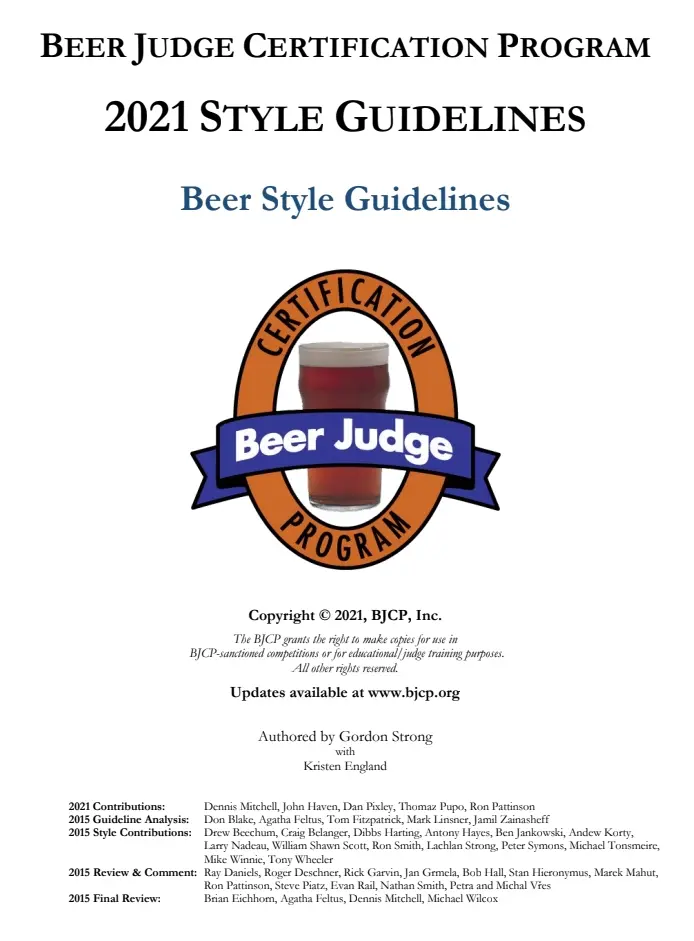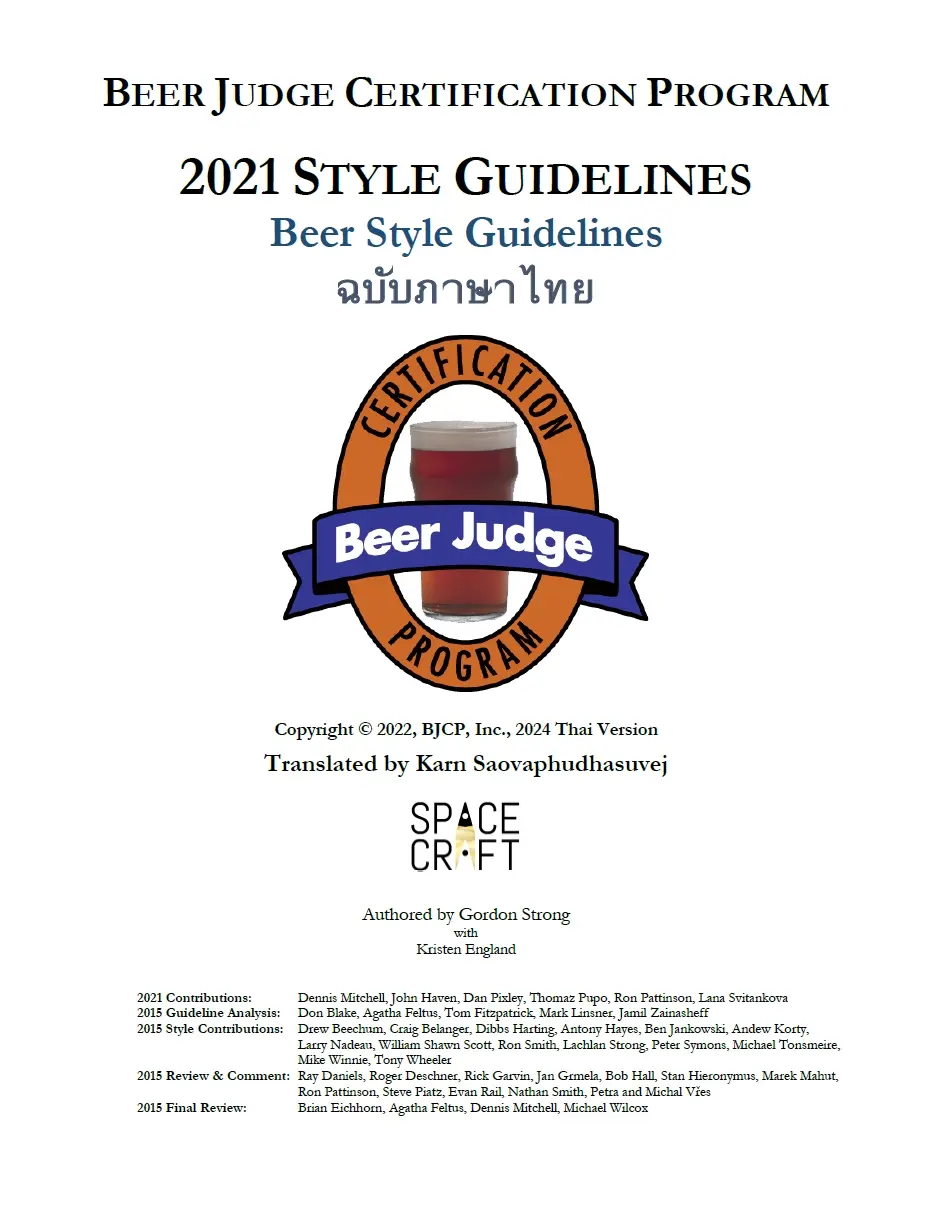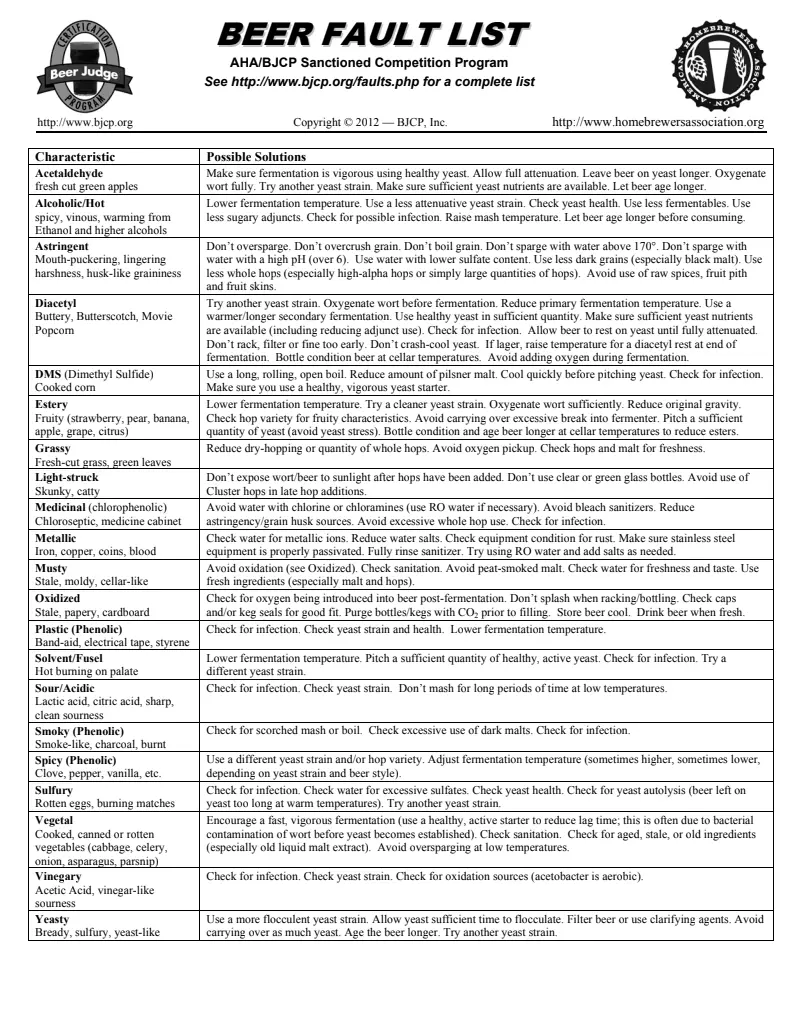Guidelines Download
Beer Style Shortcuts
21A. American IPA
Overall Impression: A decidedly hoppy and bitter, moderately strong, pale American ale. The balance is hopforward, with a clean fermentation profile, dryish finish, and clean, supporting malt allowing a creative range of hop character to shine through.
Aroma: A prominent to intense hop aroma often featuring American or New World hop characteristics, such as citrus, floral, pine, resin, spice, tropical fruit, stone fruit, berry, or melon. Low to medium-low clean, grainy maltiness supports the hop presentation. Generally clean fermentation profile, but light fruitiness acceptable. Restrained alcohol optional.
Appearance: Color ranging from medium gold to light reddish-amber. Clear, but light haze allowable. Medium-sized, white to off-white head with good persistence.
Flavor: Medium to very high hop flavor (same descriptors as aroma). Low to medium-low clean and grainy maltiness, possibly with light caramel and toast flavors. Medium-high to very high bitterness. Dry to medium-dry finish. Hoppy, bitter aftertaste with supportive malt. Low esters optional. Background clean alcohol flavor optional.
Mouthfeel: Medium-light to medium body, with a smooth texture. Medium to medium-high carbonation. No harshness. Very light, smooth warmth optional.
Comments: The basis for many modern variations, including the stronger Double IPA as well as IPAs with various other ingredients. Those other IPAs should generally be entered in the 21B Specialty IPA style. An India Pale Lager (IPL) can be entered as an American IPA if it has a similar character, otherwise 34B Mixed-Style Beer. Oak is inappropriate in this style; if noticeably oaked, enter in 33A Wood-Aged Beer. Dry, sharply bitter, clear examples are sometimes known as West Coast IPA, which is really just a type of American IPA.
History: The first modern American craft beer adaptation of this traditional English style is generally believed to be Anchor Liberty Ale, first brewed in 1975 and using whole Cascade hops; the style has evolved beyond that original beer, which now tastes more like an American Pale Ale in comparison. American-made IPAs from earlier eras were not unknown (particularly the well-regarded Ballantine’s IPA, an oak-aged beer using an old English recipe). This style is based on the modern craft beer examples.
Characteristic Ingredients: Pale base malt. American or English yeast with a clean or slightly fruity profile. Generally all-malt, but sugar additions are acceptable. Restrained use of crystal malts. Often uses American or New World hops but any are varieties are acceptable; new hop varieties continue to be released and may be used even if they do not have the sensory profiles listed as examples.
Style Comparison: Stronger and more highly hopped than American Pale Ale. Compared to English IPA, has less caramel, bread, and toast; often more American or New World hops; fewer yeast-derived esters; less body and often a more hoppy balance; and is slightly stronger than most examples. Less alcohol than a Double IPA, but with a similar balance.
Vital Statistics: OG: 1.056 – 1.070
IBUs: 40 – 70 FG: 1.008 – 1.014
SRM: 6 – 14 ABV: 5.5 – 7.5%
Commercial Examples: Bell’s Two-Hearted Ale, Cigar City Jai Alai, Fat Heads Head Hunter IPA, Firestone Walker Union Jack, Maine Lunch, Russian River Blind Pig IPA
Tags: high-strength, pale-color, top-fermented, northamerica, craft-style, ipa-family, bitter, hoppy
21C. Hazy IPA
Overall Impression: An American IPA with intense fruit flavors and aromas, a soft body, smooth mouthfeel, and often opaque with substantial haze. Less perceived bitterness than traditional IPAs but always massively hop-forward.
Aroma: Intense hop aroma, with stone fruit, tropical fruit, citrus, or other fruity qualities; not grassy or herbal. Clean, neutral, grainy, or lightly bready malt in the background; no caramel or toast. Absence of any malt character is a fault. Neutral to fruity fermentation character. Esters from yeast and hops should not clash. A creamy, buttery, or acidic aroma is inappropriate. Light alcohol aroma optional.
Appearance: Color ranging from straw to very light amber, sometimes with an orange hue. Hazy, often opaque, clarity; should not be cloudy or murky. The opacity can add a ‘shine’ to the beer and make the color seem darker. Any visible floating hop matter, yeast clumps, or other particulates is a fault. Medium to rocky, meringue-like white head with high to very high retention.
Flavor: High to very high fruity hop flavor, same descriptors as aroma. Low to medium malt flavor, same descriptors as aroma. Low to medium-high perceived bitterness, often masked by the fuller body and soft, off-dry to medium finish. The hop character in the aftertaste should not be sharp or harsh. Neutral to fruity fermentation profile, supportive of the hops. Should not be sweet, although high ester levels and lower bitterness may sometimes give that impression. Background alcohol flavor optional.
Mouthfeel: Medium to medium-full body. Medium carbonation. Smooth. No harshness. Light warmth optional. The beer should not have a creamy or viscous mouthfeel, an acidic twang, or a raw starch texture.
Comments: Also known as New England IPA or NEIPA. An emphasis on late hopping, especially dry-hopping, with hops with tropical fruit qualities lends the ‘juicy’ character for which this style is known. Heavy examples suggestive of milkshakes, creamsicles, or fruit smoothies are outside this style; IPAs should always be drinkable. Haziness comes from dry-hopping, not suspended yeast, starch haze, or other techniques; a hazy shine is desirable, not a cloudy, murky mess.
History: A modern craft beer style originating in the New England region of the United States as an American IPA variant. Alchemist Heady Topper is believed to be the original inspiration as the style grew in popularity during the 2010s. The style continues to evolve, including a trend towards lower bitterness and using the style as the base for other additions.
Characteristic Ingredients: Grist like an American IPA, but with more flaked grains and less caramel or specialty malts. American or New World hops with fruity characteristics. Neutral to estery yeast. Balanced to chloride-rich water. Heavily dry-hopped, partly during active fermentation, using a variety of hopping doses and temperatures to emphasis depth of hop aroma and flavor over bitterness. Biotransformation of hop oils during fermentation adds to the depth and fruit complexity.
Style Comparison: Has a fuller, softer mouthfeel, a more fruit-forward late hop expression, a more restrained perceived bitterness balance, and a hazier appearance than American IPA. Many modern American IPAs are fruity and somewhat hazy; examples with a dry, crisp finish, at most medium body, and high perceived bitterness should be entered as 21A American IPA. Noticeable additions of fruit, lactose, vanilla, etc. to increase the fruity, smooth character should be entered in a specialty category defined by the additives (e.g., 29A Fruit Beer, 29C Specialty Fruit Beer, 30D Specialty Spice Beer).
Vital Statistics: OG: 1.060 – 1.085
IBUs: 25 – 60 FG: 1.010 – 1.015
SRM: 3 – 7 ABV: 6.0 – 9.0%
Commercial Examples: Belching Beaver Hazers Gonna Haze, Hill Farmstead Susan, Other Half Green Diamonds Double IPA, Pinthouse Electric Jellyfish, Tree House Julius, Trillium Congress Street, WeldWerks Juicy Bits
Tags: high-strength, pale-color, top-fermented, northamerica, craft-style, ipa-family, bitter, hoppy
29A. Fruit Beer
Overall Impression: A pleasant integration of fruit with beer, but still recognizable as beer. The fruit character should be evident but in balance with the beer, not so forward as to suggest an artificial product.
Aroma: Varies by base style. The fruit character should be noticeable in the aroma; however, some fruit (e.g., raspberries, cherries) have stronger aromas and are more distinctive than others (e.g., blueberries, strawberries) – allow for a range of fruit character and intensities from subtle to aggressive. Hop aroma may be lower than in the base style to better show the fruit character. The fruit should add an extra complexity, but not be so prominent as to unbalance the resulting presentation.
Appearance: Varies by base style and special ingredients. Lighter-colored beer should show distinctive ingredient colors, including in the head. The color of fruit in beer is often lighter than the flesh of the fruit itself and may take on slightly different shades. Variable clarity, although haze is generally undesirable. Some ingredients may impact head retention.
Flavor: Varies by base style. As with aroma, distinctive fruit flavors should be noticeable, and may range in intensity from subtle to aggressive, but the fruit character should not be so artificial or inappropriately overpowering as to suggest a ‘fruit juice drink.’ Bitterness, hop and malt flavors, alcohol content, and fermentation byproducts, such as esters, should be appropriate for the base style, but be harmonious and balanced with the distinctive fruit flavors present.
Fruit generally adds flavor not sweetness, since fruit sugars usually fully ferment, thus lightening the flavor and drying out the finish. However, residual sweetness is not necessarily a negative characteristic unless it has a raw, unfermented quality. Some fruit may add sourness, bitterness, and tannins, which must be balanced in the resulting flavor profile.
Mouthfeel: Varies by base style. Fruit often decreases body, and makes the beer seem lighter on the palate. Some smaller and darker fruits may add a tannic depth, but this astringency should not overwhelm the base beer.
Comments: The description of the beer is critical for evaluation; judges should think more about the declared concept than trying to detect each individual ingredient. Balance, drinkability, and execution of the theme are the most important deciding factors.
The fruit should complement the original style and not overwhelm it. Base style attributes will be different after the addition of fruit; do not expect the beer to taste identical to the unadulterated base style.
Fruit Beers based on a Classic Style should be entered in this style, except Lambic – there is a special style for Fruit Lambic (23F). Fruited sour or mixed fermentation beers without a Classic Style base should be entered in the 28C Wild Specialty Beer. Fruited versions of sour Classic Style beers (e.g., Flanders Red, Oud Bruin, Gose, Berliner Weisse) should be entered in 29A Fruit Beer. Fruit-based versions of Classic Styles where spices are an inherent part of the Classic Style’s definition (e.g., Witbier, Gose) do not count as a Spice Beer for entering purposes.
Entry Instructions: The entrant must specify the type(s) of fruit used. Entrant must specify a description of the beer, identifying either a Base Style or the ingredients, specs, or target character of the beer. A general description of the special nature of the beer can cover all the required items.
Vital Statistics: OG, FG, IBUs, SRM, and ABV will vary depending on the underlying base beer, but the fruit will often be reflected in the color.
Commercial Examples: 21st Amendment Watermelon Wheat, Anderson Valley Blood Orange Gose, Avery Liliko’i Kepolo, Ballast Point Grapefruit Sculpin, Bell’s Cherry Stout, Founders Rübæus
Tags: specialty-beer, fruit



